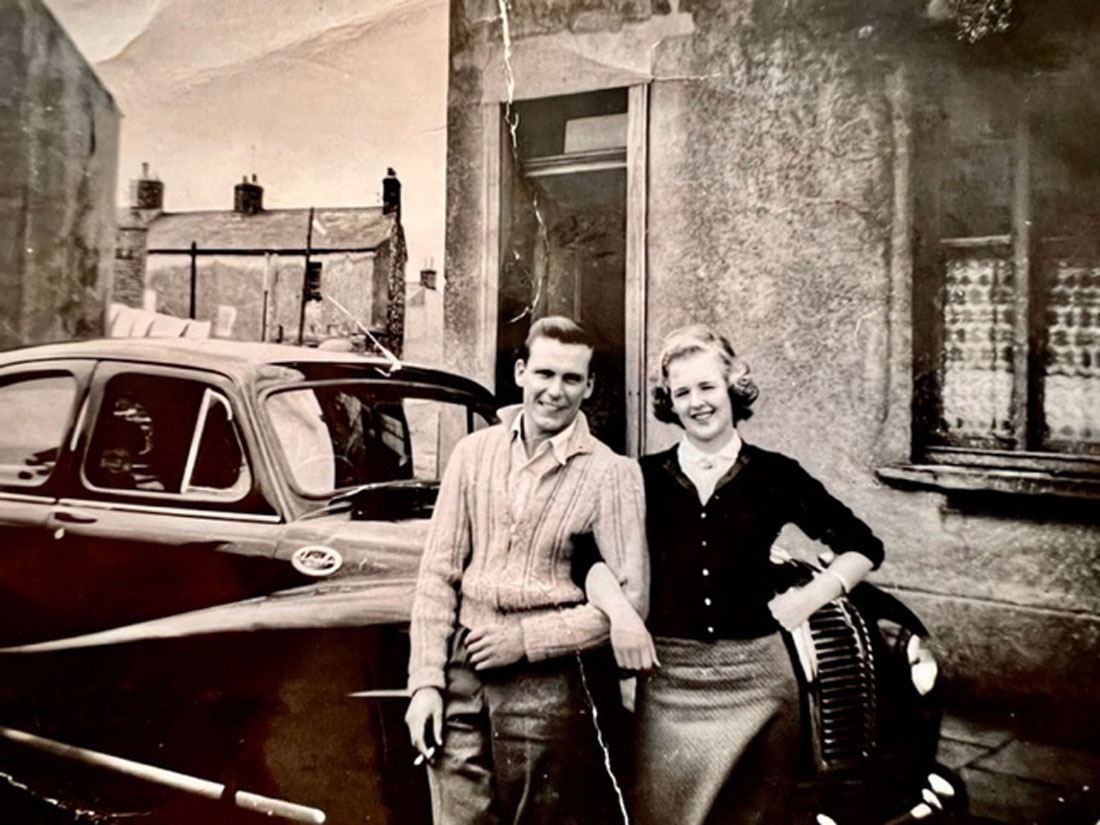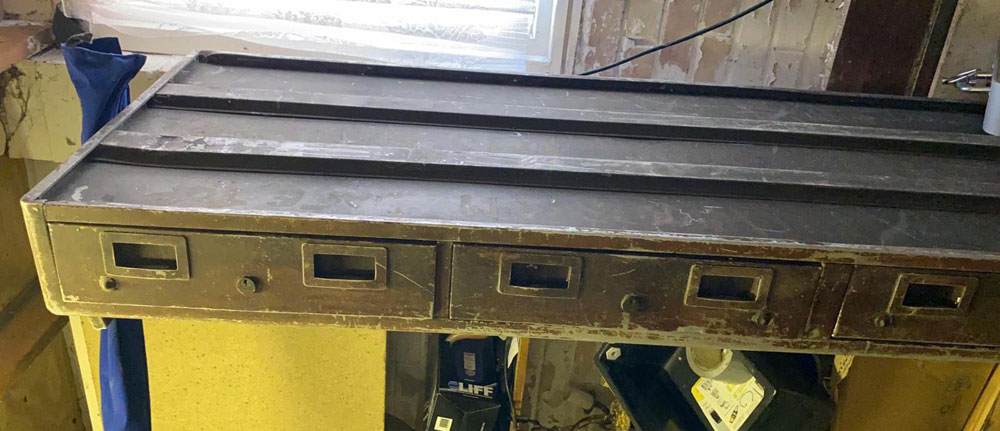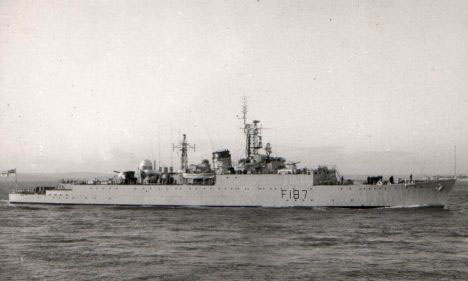
 HMS WHIRLWIND
HMS WHIRLWINDCommanding Officers
| Cdr Reginald St. P. Parry (27 February, 1918 – 20 February, 1919) Lt Cdr Brian C. Gourley (20 February, 1919 – August, 1919) Lt Cdr William A. C. Salmond (Aug. 1919 – 21 March 1921) committed suicide aboard (gunshot) Lt Cdr Thomas C. A. H. Ouchterlony (April, 1921 – 3 May 1923) Lt Cdr Ivan B. Colvin (April 1923 – 5 May, 1925) Lt Cdr Donal Scott McGrath RN (2 May 1925 - Jan 1926) Lt Cdr Gerald M. McKenna (Dec. 1925– 6 May, 1926) Lt Cdr John D. Harvey (1 May, 1926 – 10 December, 1927) Lt Cdr Henry Clanchy (29 March 1928 – 1929) |
Lt Cdr Francis S. W. de Winton (2 Dec. 1929 – 30 Dec. 1931) Lt Cdr Richard E. Hyde-Smith (31 Dec. 1931 - Wartime CO's Lt.Cdr. Michael Wentworth Ewart-Wentworth, RN (15 June - 10 Oct 1939) Lt.Cdr. John Malcolm Rodgers, RN (10 Oct 1939 - 5 Jul 1940)
ship lost under his command
|
Officers
| Lt C.R. Box RN (23 May - 5 July 1940) Lt Surg J. Carrick RNVR (12 Feb - 5 July 1940) Sub Lt V.W. Chacksfield (8 Jan - 5 July 1940) Cd Eng D.G.B. Cock RN (8 Feb 1937 - 5 July 1940) |
Sub Lt D.S. Cox RNR (14 Dec 1939 - 5 July 1940) Gunner (T) L. Davis RN (8 June 1939 - 5 July 1940) Sub Lt R.D. Hamilton-Bate RN (15 June 1939 - 5 July 1940) Mid E.A. Hamilton RN (29 Aug 1939 - 5 July 1940) Lt Henry E.P. Wilkin RN (1 June 1939 - 5 July 1940) |
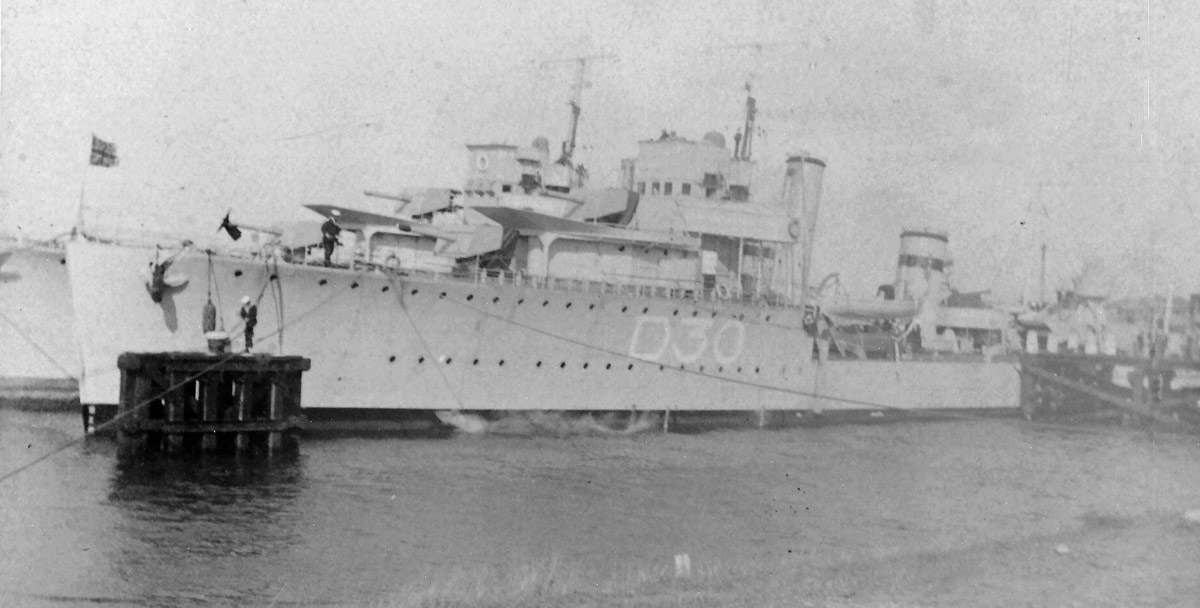
In
the 1920s collisions between warships and submarines operating on the
surface in close proximity to each other were not uncommon. Submarines were particularly vulnerable when surfacing.
The low profile of a surfaced submarine made it difficult to spot and
visibility from the conning tower of a submarine was limited even in
good sea conditions.
In June 1922 the submarine H24 was operating wiith the 3rd Submarine Flotilla based at Portsmouth with HMS Maidstone as her depot ship was rammed by HMS Vancouver whilst submerged during exercises. The Conning tower was badly damaged and although the Vancouver left part of one of her screws embedded in the junction of the conning-tower and the pressure hull there were no breaches. HMS Whirlwind was able to rescue the crew and there were no casualties. HMS Vancouver was renamed HMS Vimy in 1928.
Three months earlier on 23 March 1922, HMS Versatile, a sister ship of Whirlwind and Vancouver,
was steaming off Europa Point, Gibraltar, at 20 knots with other
destroyers while British submarines practiced attacks on them. The
submarine H42 surfaced unexpectedly ahead of her. Versatile
went full speed astern and put her helm over hard to port, but
rammed H42 abaft the conning tower, almost slicing the submarine in
half. H42 sank with the loss of all hands. An investigation found H42
at fault for surfacing where she did against instructions. HMS Versatile was also quite badly damaged and underwent repairs at Gibraltar.
On 10 January 1924, while conducting training exercises in the English Channel, the Revenge Class Battleship, HMS Resolution ran into and sank the British submarine HMS L24 as she was surfacing, damaging her bow in the collision. Crewmen aboard Resolution reported feeling a shock at 11:13, but they were unaware that they had struck the submarine; it became clear later that day when the fleet returned to port and L24 was found to be missing. The submarine was sunk with the loss of all hands. The report of the enquiry into the loss of L24 can be seen in the National Archives, ADM 116/2250.
The first British warship to be lost in World War II was the submarine, HMS Oxley, torpedoed and sunk by submarine, HMS Triton on 10 December 1939. The CO of Oxley,
Lt Cdr Harold G Bowerman, was one of only two survivors. The
circumstances of her loss were deliberately kept a mystery for many
years but are described in detail in the Australian Naval Historical Review. Bowerman was cleared and went on to command four destroyers, including HMS Walpole which brought industrial diamonds from Amsterdam in May 1940. HMS Triton was lost with all hands in the Adriatic in December 1940, the cause never fully established.
Captain of the Heads, 1938
The
situation in Europe was becoming rather volatile. Germany had already
began rearming at an alarming rate and was producing U-boats as fast as
possible and also producing bomber and fighter aircraft, all contrary
to previous international treaties and conditions and so led to my
introduction to the V&Ws.
At
about 0200 on a Saturday in September 1938 I was sleeping in my hammock
in 5GG mess R.N.B. Chatham when I was aroused by someone switching on
the lights. It was an R.P.O, who was calling out a list of names
and asking each one "Can you ride a Bike?" On receiving an affirmative,
he was instructed to report to the main gate where he would be sent
round on a bicycle delivering call up messages to reservists in the
Medway. One wit, hoping perhaps to avoid the task replied "No", only to
be told to report to the main gate where he would have to walk round
delivering call up messages.
Before
switching off the lights the R.P.O. informed us that, due to the Munich
crisis the Fleet was being mobilised, and that most of us would be
drafted to ships that day. So much for the short week end leave that I
was expecting. That day in the barracks was one of watching and
waiting. Watching the huge notice boards that had been placed in the
drill shed and trying to find out which ship you had been sent to. I
eventually found my name, I was posted to Whirlwind,
a V&W destroyer. It was then a question of waiting, waiting until
about 1600 hrs when, after much hanging around, we were marched to the
dockyard to join Whirlwind. I was then an AB SG and was allocated to
number two mess, top division, trainer of 'B' gun, and "Captain of the
Heads" (toilets), a very privileged job, or so I thought until I saw
them. They were in a terrible state and to put it crudely stunk! The
ship had been in reserve for many years and I do not think that any
work had been done in the heads during that time.
The
first night we stored ship and the following day went to Shore Reach to
ammunition. We then went to Portsmouth and spent the next few
days at sea doing all the commissioning exercises. Whenever
possible I worked in the Heads, and got them up to a reasonable
standard to satisfy myself and the chief of the mess decks. One bonus
was that I had my own "Caboosh". There were two toilets marked, C.&
P.O's and a third one with no marking. I decided that this one was
spare and I rigged up a nice little den for myself with photographs, a
line for my dhobying and other personal items. I had the best caboosh
in the ship. Alas it came to an end one day whilst at sea when the
Captain appeared in the galley flat and asked where his sea heads was.
It was my caboosh. He naturally exploded when he opened the door and
saw my dhobying hanging there. That was it for me. I lost my Captaincy
and was back working part of ship.
The commission only lasted for about a month, following Neville Chamberlain's return from Munich waving a piece of paper saying "Peace in our time". We paid off and it was back to R.N.B.
HMS Whirlwind was a popular ship - with the Ladies!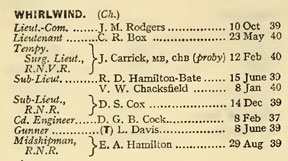 On the 5th July 1940 HMS Whirlwind together with HMS Westcott were ordered to carry out a U-boat hunt off Lands End when Whirlwind was
torpedoed and badly damaged by U-34 some 120 miles off Lands End. U-34
reported that the forepart broke off, sinking immediately, while the
rest of the ship stayed afloat. After
HMS Westcott rescued the survivors (57 men were killed and 57 of the crew of 114 rescued) she had
to be sunk by gunfire from Westcott who returned to Falmouth with the survivors.
On the 5th July 1940 HMS Whirlwind together with HMS Westcott were ordered to carry out a U-boat hunt off Lands End when Whirlwind was
torpedoed and badly damaged by U-34 some 120 miles off Lands End. U-34
reported that the forepart broke off, sinking immediately, while the
rest of the ship stayed afloat. After
HMS Westcott rescued the survivors (57 men were killed and 57 of the crew of 114 rescued) she had
to be sunk by gunfire from Westcott who returned to Falmouth with the survivors. | ABEL, Jack, Stoker 1c, RFR, C/KX 75536 D 156, killed BALLARD, George, Able Seaman, RFR, C/J 99895 B 22607, killed BARNES, Henry G, Ordinary Seaman, RNVR, C/LD/X 5134, killed BARTON, William C, Able Seaman, RFR, C/J 108614, killed BLACK, Thomas B, Stoker 2c, P/KX 97334, killed BRANCH, Albert G, Chief Engine Room Artificer 2c, C/M 26911, killed BRIDGER, George C, Able Seaman, RFR, C/J 103229 D 488, killed BROWN, Thomas, Leading Sick Berth Attendant, RNASBR, C/X 6201, killed BURDETT, Alfred N R, Able Seaman, RFR, C/J 99895, killed CHILDS, Frederick A, Able Seaman, C/JX 135524, killed CLENDINNING, David, Able Seaman, RFR, C/SSX 13199 B 23700, killed COLE, William, Able Seaman, RFR, C/SS 11288 D 982, killed COOMBER, Frank W J, Able Seaman, RFR, C/J 55345 D 1186, killed COWDEROY, Leonard, Able Seaman, RFR, C/J 103960 D 378, killed COX, Arthur H, Able Seaman, RFR, C/J 102131 D 586, killed CRAWFORD, Victor C, Able Seaman, RFR, C/J 115215, killed DALE, Thomas E, Able Seaman, RFR, C/J 87997 D 1490, killed DAVIS, Arthur W, Able Seaman, RFR, C/J 99658 D 696, killed DOWLING, Reginald V, Ordinary Seaman, RNVR, C/LD/X 5094, killed |
DUNKLEY, Leslie T, Signalman, RFR, C/J 106206 D 266, killed FLOYD, William J, Able Seaman, RFR, C/J 11443, killed GAHAGON, James, Stoker 1c, RFR, C/K 62415 D 396, killed GARSTIN, William P B, Leading Stoker, C/K 61782, killed GOULD, Arthur E, Able Seaman, RFR, C/J 97291, killed GOULDEN, John L, Able Seaman, RFR, C/SSX 12591 D 556, killed HAYNES, George W, Stoker Petty Officer, C/K 21829 Pens No 24033, killed HILL, Frederick, Ordinary Seaman, C/SSX 30260, killed HILLS, Robert J, Canteen Manager, NAAFI, killed HUTCHINS, Arthur E, Telegraphist, RFR, C/J 89818 D 690, killed LONDON, Gilbert I, Stoker 1c, C/KX 90467, killed MARTIN, Arthur C, Signalman, RFR, C/J 77527 D 1090, killed MARTIN, George J, Able Seaman, RFR, C/SS 10929 D 1004, killed MCMILLAN, Norman, Seaman, RNR, C/X 10685 B, killed MILES, Percy T N, Able Seaman, RFR, C/J 103089 D 346, killed MORRISON, Sydney G, Stoker 1c, C/KX 83363, killed NICHOLSON, George F, Able Seaman, RFR, C/J 105788 D 318, killed NIX, Cyril, Assistant Cook, C/MX 60818, killed PARKER, Edward F, Able Seaman, RFR, C/SS 10133 D 1028, killed |
PAYNE, John C, Able Seaman, RFR, C/SS 10296 D 324, killed PIMM, William G, Able Seaman, RFR, C/SSX 13381, killed PORTER, Thomas, Able Seaman, RFR, C/J 101017 D508, killed RABBITT, Herbert J, Engine Room Artificer 1c, C/M 7828 Pens No 7828, killed RALPH, William G, Chief Petty Officer, C/J 32354 Pens No 13643, killed RIPLEY, Harry G, Able Seaman, RFR, C/SSX 12511 D 1498, killed ROBERTS, Alfred J, Stoker 1c, C/K 65345, killed SMITH, Alfred T F, Able Seaman, RFR, C/J 110164 D 110, killed SQUIRES, Reginald H G, Able Seaman, C/JX 148209, killed STACEY, Ronald W, Able Seaman, RFR, C/J 108472 D 228, killed STREATFIELD, John, Able Seaman, RFR, C/J 97386 D 490, killed TASKER, Frank, Able Seaman, RFR, C/J 100589 D438, killed THORNDYCROFT, Arthur, Petty Officer Cook, C/M 36009 Pens No 11636, killed WAITE, Frederick J W, Able Seaman, RFR, C/J 96345 D 640, killed WELCH, Spencer M, Able Seaman, RFR, C/J 109700 D 1558, killed WHITE, George C, Able Seaman, RFR, C/SS 8126 D 1544, killed WRIGHT, William H, Able Seaman, C/SSX 18820, killed YEOMANS, Edward T, Stoker 1c, RFR, C/KX 75124 D 190, killed |
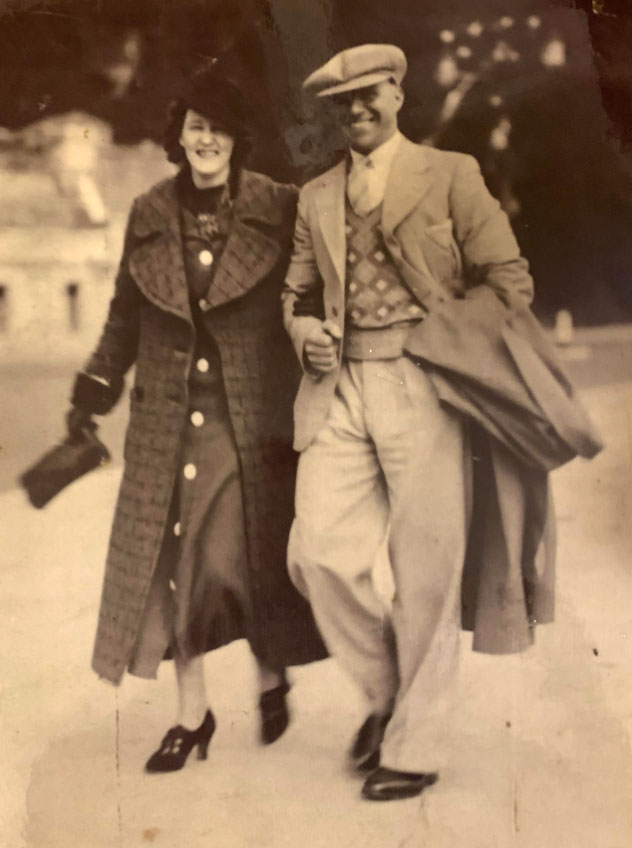 Mary Eileen “Ailee” & William “George” Pimm In 1937 after George Pimm left the Navy
All photographs are courtesy of Cynthia Sculler, Mother of Julia Andrews |
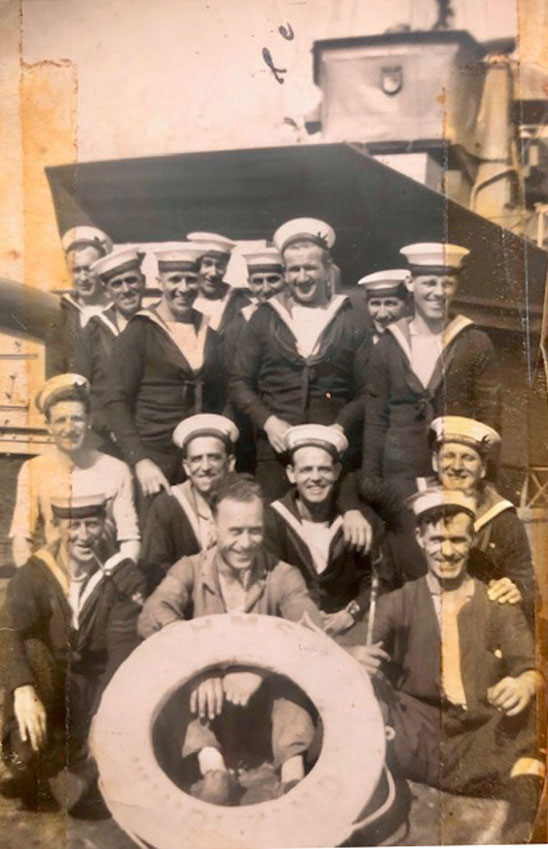 George Pimm is standing third from left on this poor image taken aboard HMS Whilrwind
Can anybody identify the other men? |
